Being able to tell if a logo was produced by an algorithm helps protect brand originality and long-term distinctiveness, especially for beginners evaluating designers or templates online. AI tools can speed up mockups, but they also tend to produce lookalike symbols, trendy effects, and limited typography that can weaken brand identity over time.
Your Texas business deserves the best. Explore our professional logo design services in Austin, Houston, Dallas, and San Antonio.
Why It’s Important to Identify AI-Generated Logos
AI generators often remix common icon motifs and color trends, which can lead to generic marks that risk duplication across industries and platforms. Some tools generate outputs using trained datasets that may overlap heavily with public iconography, introducing originality and legal uncertainties that need careful review by a human professional. A human review helps ensure concept, narrative, and long-term brand cohesiveness beyond surface-level polish.
Common characteristics of AI-generated logos
-
Overly perfect symmetry and geometry: AI tends to favor mathematically precise circles, mirrored shapes, and “balanced” layouts that can feel sterile or templated at a glance.
-
Generic icons and stock-like elements: Expect frequent use of shields, stars, leaves, and abstract orbs that echo stock libraries across multiple outputs.
-
Trendy gradients and color effects: Generators routinely apply uniform, on-trend gradients and neon glows that look impressive on screen but don’t always scale or print cleanly.
-
Limited typography nuance: Tools often rotate among a small, safe set of sans-serif families and preset pairings, leading to similar “voice” across different brands.
-
Shallow concept or story: Outputs may look polished but lack the custom symbolism and narrative that come from strategy-led human design workshops.
Technical clues in files and quality
-
Metadata hints: Some exports contain editor or generator tags in file metadata (e.g., app identifiers) viewable through OS info panels or metadata viewers, which can hint at tool-based origins (Hive AI).
-
Resolution or artifact patterns: Watch for odd edge smoothing, inconsistent vector curves after tracing, or compression artifacts, especially when raster images are upscaled from low-resolution outputs (Sightengine).
-
Consistency across variations: Rapidly produced “brand kits” that reuse identical icon geometry with different colors or names can signal generator patterns rather than custom ideation.
Recognizing popular AI generator styles
-
Canva and Looka: Clean, modern icon styles, heavy use of gradients, and quick brand kit exports are common signatures for beginners to notice when many options look “samey” across niches (Canva, Looka).
-
Midjourney and DALL·E: Artistic or painterly textures, photoreal lighting, and inconsistent letterforms when asked to render text can hint at image-model based workflows rather than vector-native output.
-
Tailor Brands and LogoAI: Template-driven grids, similar icon families across categories, and limited type pairings can produce fast but familiar-looking outcomes for unrelated companies (LogoAI, SuperAGI).
Practical steps to verify a logo’s origin
-
Run a reverse image search: Upload the logo (or a flat export) to check for near-duplicates on galleries, brand kits, or portfolios that might indicate generator reuse patterns across multiple outputs.
-
Ask for source files and process: Request editable vector files (e.g., .ai, .svg) and any rough sketches; genuine concept development often includes iterations and rationale that go beyond a single output screen.
-
Inspect metadata or fingerprints: Use standard file info panels or image-metadata tools to check creator fields and software tags that may reveal generator pipelines or batch exports.
-
Get a human second opinion: A quick review from an experienced designer can catch recycled iconography, weak type hierarchy, and scaling risks that algorithms miss.
See our logo design work and discover how we turn ideas into unforgettable brands.
Conclusion
AI can be useful for brainstorming, but telltale cues—generic icons, over-polished symmetry, trend-heavy gradients, and shallow narrative—often reveal generator origins, especially when paired with metadata or reverse-search checks. For a distinctive brand, validate origins, examine files, and rely on human judgment to ensure the logo reflects real strategy and story—not just style trends.
Get a distinctive, human-made logo designed to avoid AI lookalikes, symmetry glitches, and trademark risks.
FAQ
-
How accurate is reverse image search for detecting AI logos?
Reverse search can surface duplicates or near-matches from generator galleries, but it’s not foolproof because many outputs are slightly varied or behind login walls; use it alongside file checks and expert reviews. -
Can AI-generated logos be customized enough to appear human-made?
Some tools allow edits to colors, icons, and type, which can mask similarities; however, underlying structures and icon families often remain recognizable to trained eyes. -
Are there legal risks in using AI-generated logos?
Potential risks include similarity to existing marks and unclear originality depending on training data and template reuse; a trademark search and professional review are recommended before adoption. -
What free tools can beginners use to inspect metadata?
Check the file’s Properties/Info panel in your operating system, or use an online metadata viewer; detection platforms can also flag AI-generated images at scale where applicable. -
How should beginners balance AI tools with human creativity?
Use generators for initial moodboards or to spark ideas, then collaborate with a designer to refine concept, storytelling, legibility, and scalability for real-world use.
